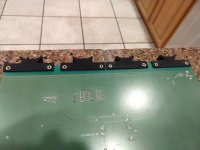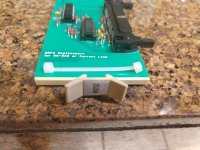vrs42
Veteran Member
I got the rivet set thing today and chucked it in the drill press. The hole in the table was proving to be problematic, as the rivet needed to be braced firmly from the rear. I used a file to cover the hole, rather than adjust the the table and have to reset it later. That gave the flanges a bit of a textured look. Anyway there's a clear tactile difference between setting the rivet and trying to drive it through the handle, which made the setup fairly easy to use.
One thing that was less easy, is that the newer boards are a little thicker than the DEC boards, and the distance between the ledge in the handle and the holes didn't have any clearance on the board I was using (a Hachtmann serial card which happened to have no handles).
You can see that my skills are sort of meh, but the handles and rivets are set OK.


Is there a reason why the flange side should go on the PCB (component) side? I put it on the handle (solder) side to make it harder to deform the soft plastic of the handle.
Vince
(My board has had the SMT electrolytic replaced by a through hole part soldered into the spare IC's power holes, if anyone wondered why it's missing in the photo.)
One thing that was less easy, is that the newer boards are a little thicker than the DEC boards, and the distance between the ledge in the handle and the holes didn't have any clearance on the board I was using (a Hachtmann serial card which happened to have no handles).
You can see that my skills are sort of meh, but the handles and rivets are set OK.


Is there a reason why the flange side should go on the PCB (component) side? I put it on the handle (solder) side to make it harder to deform the soft plastic of the handle.
Vince
(My board has had the SMT electrolytic replaced by a through hole part soldered into the spare IC's power holes, if anyone wondered why it's missing in the photo.)


